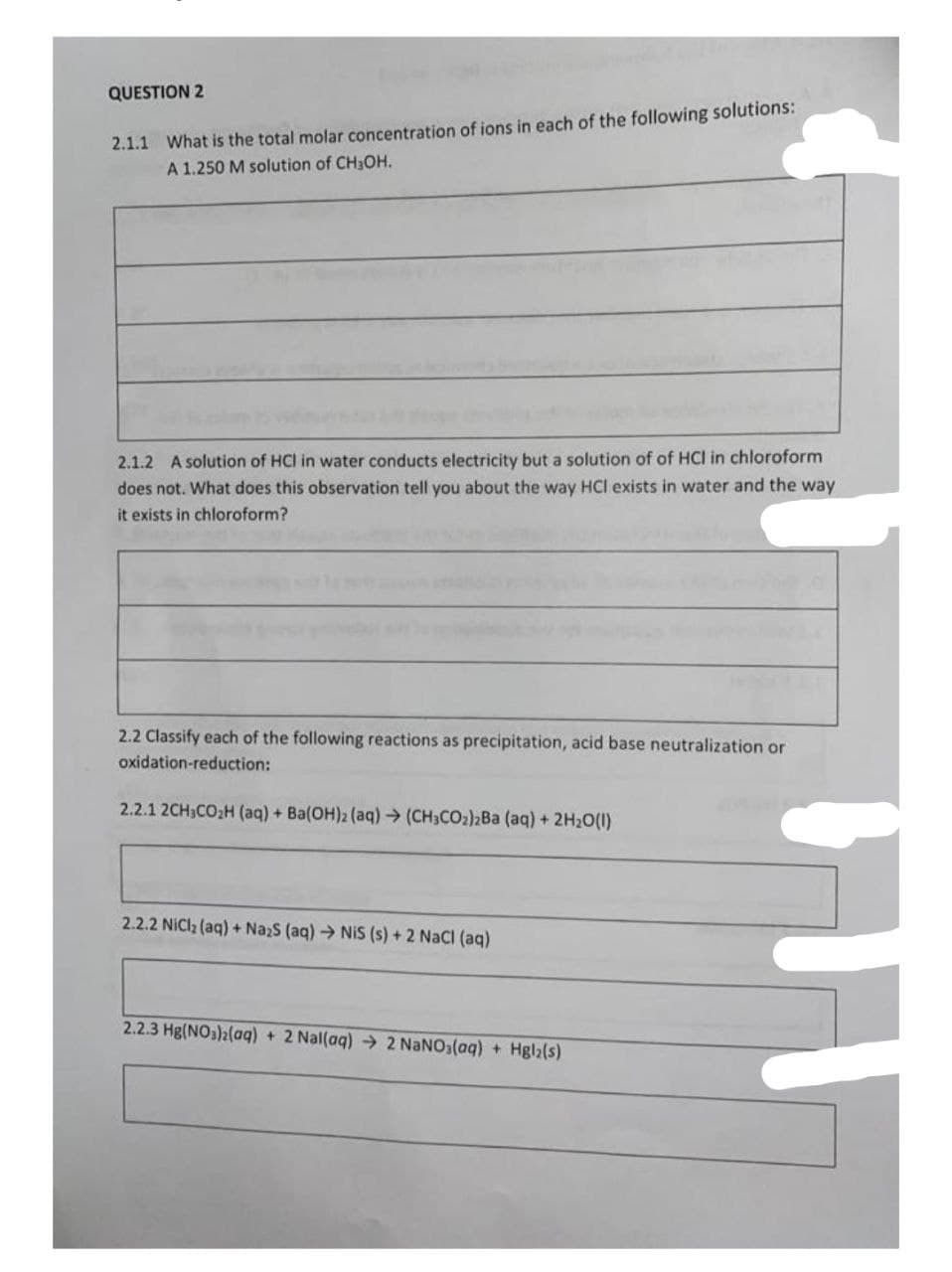QUESTION 2 2.1.1 What is the total molar concentration of ions in each of the following solutions: A 1.250 M solution of CH₂OH. 2.1.2 A solution of HCI in water conducts electricity but a solution of of HCI in chloroform does not. What does this observation tell you about the way HCI exists in water and the way it exists in chloroform? 2.2 Classify each of the following reactions as precipitation, acid base neutralization or oxidation-reduction: 2.2.1 2CH3CO₂H (aq) + Ba(OH)2 (aq) → (CH3CO₂)2Ba (aq) + 2H₂O(l) 2.2.2 NiCl₂ (aq) + Na₂S (aq) → NiS (s) + 2 NaCl (aq) 2.2.3 Hg(NO3)2(aq) + 2 Nal(aq) → 2 NaNO3(aq) + Hgla(s)
QUESTION 2 2.1.1 What is the total molar concentration of ions in each of the following solutions: A 1.250 M solution of CH₂OH. 2.1.2 A solution of HCI in water conducts electricity but a solution of of HCI in chloroform does not. What does this observation tell you about the way HCI exists in water and the way it exists in chloroform? 2.2 Classify each of the following reactions as precipitation, acid base neutralization or oxidation-reduction: 2.2.1 2CH3CO₂H (aq) + Ba(OH)2 (aq) → (CH3CO₂)2Ba (aq) + 2H₂O(l) 2.2.2 NiCl₂ (aq) + Na₂S (aq) → NiS (s) + 2 NaCl (aq) 2.2.3 Hg(NO3)2(aq) + 2 Nal(aq) → 2 NaNO3(aq) + Hgla(s)
Principles of Modern Chemistry
8th Edition
ISBN:9781305079113
Author:David W. Oxtoby, H. Pat Gillis, Laurie J. Butler
Publisher:David W. Oxtoby, H. Pat Gillis, Laurie J. Butler
Chapter17: Electrochemistry
Section: Chapter Questions
Problem 106CP
Related questions
Question

Transcribed Image Text:QUESTION 2
2.1.1 What is the total molar concentration of ions in each of the following solutions:
A 1.250 M solution of CH3OH.
2.1.2 A solution of HCI in water conducts electricity but a solution of of HCI in chloroform
does not. What does this observation tell you about the way HCI exists in water and the way
it exists in chloroform?
2.2 Classify each of the following reactions as precipitation, acid base neutralization or
oxidation-reduction:
2.2.1 2CH3CO₂H (aq) + Ba(OH)2 (aq) → (CH3CO₂)2Ba (aq) + 2H₂O(1)
2.2.2 NiCl₂ (aq) + Na2S (aq) → NiS (s) + 2 NaCl (aq)
2.2.3 Hg(NO3)2(aq) + 2 Nal(aq) → 2 NaNO3(aq) + Hgla(s)
AA
Expert Solution
This question has been solved!
Explore an expertly crafted, step-by-step solution for a thorough understanding of key concepts.
This is a popular solution!
Trending now
This is a popular solution!
Step by step
Solved in 3 steps with 1 images

Knowledge Booster
Learn more about
Need a deep-dive on the concept behind this application? Look no further. Learn more about this topic, chemistry and related others by exploring similar questions and additional content below.Recommended textbooks for you

Principles of Modern Chemistry
Chemistry
ISBN:
9781305079113
Author:
David W. Oxtoby, H. Pat Gillis, Laurie J. Butler
Publisher:
Cengage Learning


Chemistry for Today: General, Organic, and Bioche…
Chemistry
ISBN:
9781305960060
Author:
Spencer L. Seager, Michael R. Slabaugh, Maren S. Hansen
Publisher:
Cengage Learning

Principles of Modern Chemistry
Chemistry
ISBN:
9781305079113
Author:
David W. Oxtoby, H. Pat Gillis, Laurie J. Butler
Publisher:
Cengage Learning


Chemistry for Today: General, Organic, and Bioche…
Chemistry
ISBN:
9781305960060
Author:
Spencer L. Seager, Michael R. Slabaugh, Maren S. Hansen
Publisher:
Cengage Learning


Chemistry & Chemical Reactivity
Chemistry
ISBN:
9781133949640
Author:
John C. Kotz, Paul M. Treichel, John Townsend, David Treichel
Publisher:
Cengage Learning

Chemistry & Chemical Reactivity
Chemistry
ISBN:
9781337399074
Author:
John C. Kotz, Paul M. Treichel, John Townsend, David Treichel
Publisher:
Cengage Learning